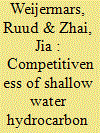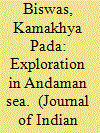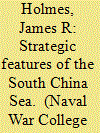|
|
|
Sort Order |
|
|
|
Items / Page
|
|
|
|
|
|
|
| Srl | Item |
| 1 |
ID:
150010


|
|
|
|
|
| Summary/Abstract |
Development of Mexican hydrocarbon reservoirs by foreign operators has become possible under Mexico's new Hydrocarbon Law, effective as per January 2015. Our study compares the economic returns of shallow water fields in the Gulf of Mexico applying the royalty and taxes due under the fiscal regimes of the U.S. and Mexico. The net present value (NPV) of the base case scenario is US$1.4 billion, assuming standard development and production cost (opex, capex), 10% discount rate accounting for the cost of capital and revenues computed using a reference oil price of $75/bbl. The impact on NPV of oil price volatility is accounted for in a sensitivity analysis. The split of the NPV of shallow water hydrocarbon assets between the two contractual parties, contractor and government, in Mexico and the U.S. is hugely different. Our base case shows that for similar field assets, Mexico's production sharing agreement allocates about $1,150 million to the government and $191 million to the contractor, while under U.S. license conditions the government take is about $700 million and contractor take is $553 million. The current production sharing agreement leaves some marginal shallow water fields in Mexico undeveloped for reasons detailed and quantified in our study.
|
|
|
|
|
|
|
|
|
|
|
|
|
|
|
|
| 2 |
ID:
133389


|
|
|
|
|
| Publication |
2014.
|
| Summary/Abstract |
In his classic collection of essays on maritime geography The Interest of America in Sea Power, Present and Future, Alfred Thayer Mahan opined that the importance of "portions of the earth's surface, and their consequent interest to mankind, differ from time to time."1 Just as the Mediterranean Sea once transfixed the minds of European strategists and policy makers, Mahan believed, at the turn of the twentieth century, the Gulf of Mexico and Caribbean Sea would obtain similar prominence in American strategic thinking. A century later, as we observe the relative balance of economic and military powers shifting to Asia and the Pacific and Indian Oceans, Mahan's teachings on geography are again instructive, as once seemingly insignificant bodies of water and island chains take on a new importance in regional security matters.
|
|
|
|
|
|
|
|
|
|
|
|
|
|
|
|
| 3 |
ID:
114911


|
|
|
| 4 |
ID:
133069


|
|
|
|
|
| Publication |
2014.
|
| Summary/Abstract |
The South China Sea is a semienclosed sea at the intersection between East Asia and the Indian Ocean region. It exhibits characteristics similar to the Mediterranean Sea and the Caribbean Sea, as well as some revealing differences. Both the similarities and the differences commend sea-power theorist Alfred Thayer Mahan's analysis of the Gulf of Mexico and the Caribbean Sea to presentday students and practitioners of maritime strategy. Mahan classified strategic features-especially prospective sites for naval stations-by their positions, strengths, and resources. This article adds a metric to his analytical template, namely, the state of relations with countries that host naval bases. He applied much the same framework to narrow seas, such as international straits, while also sizing up these passages' widths, lengths, and difficulty of transit. Here too an element warrants adding, namely, the underwater terrain-its topography and hydrography.
|
|
|
|
|
|
|
|
|
|
|
|
|
|
|
|
|
|
|
|
|